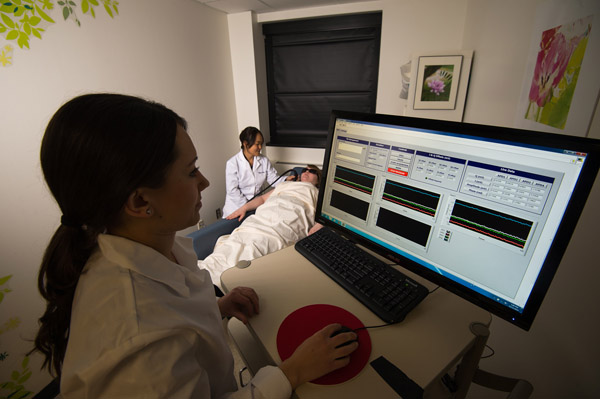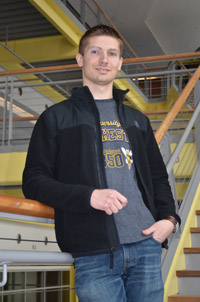Biomedical Optics: A University-wide collaboration

Regine Choe, assistant professor of biomedical engineering; Stacie Zwolski, a senior in biomedical engineering (standing in foreground); and Ashley Proctor, lab technician acting as patient, demonstrate the use of a hemodynamic optical device with a hand-held probe as a noninvasive way to monitor breast cancer therapy. The device combines a diffuse correlation spectroscopy (DCS) and a diffuse optical spectroscopy (DOS). DCS is a near-infrared optical method that quantifies deep tissue micro-vascular blood flow, and DOS provides total hemoglobin concentration and blood oxygen saturation. These hemodynamic parameters are significantly different between tumor and normal tissues, and their changes may indicate the effectiveness of cancer therapies." (CREDIT: Photo by J. Adam Fenster/University of Rochester)
 As a Ph.D. student at the University of Rochester, Daniel Savage (shown at left) has been involved in research “that is not only exciting for me personally, but also has the potential to be high impact, positively affecting the lives of countless individuals.”
As a Ph.D. student at the University of Rochester, Daniel Savage (shown at left) has been involved in research “that is not only exciting for me personally, but also has the potential to be high impact, positively affecting the lives of countless individuals.”
The project, a collaboration between Wayne Knox, professor of optics, physics and the Center for Visual Science, and Krystel Huxlin, professor of ophthalmology, neurobiology & anatomy, brain & cognitive sciences, and the Center for Visual Science, explores a novel application of femtosecond laser beams that could correct vision problems noninvasively, without the cutting involved in Lasik surgery.
“It sounds magical, but if this works out you could literally sit in a chair, look at a fixation point for a few minutes while we shine a special type of laser light into your eyes, and walk away with perfect refractive vision,” Savage said.
Not a center, not a degree . . .
This is an example of biomedical optics at the University of Rochester. Biomedical optics is not a department at UR. It’s not a center. It’s not even a degree. It is something more: the collaboration that occurs between many departments, centers and researchers, using advanced optical techniques as diverse as multi-photon laser-scanning microscopy, Raman spectroscopy, diffuse optical tomography and near-field optics to solve pressing problems in medicine and biology.
“It’s an incredible privilege and honor to be studying here at Rochester,” Savage said. “You have The Institute of Optics, which is one of the premier schools for optics. You have the Center for Visual Science -- what a hotbed that is. And you have the Flaum Eye Institute. You couldn’t ask for a better place.
Indeed, biomedical optics thrives at the University of Rochester and the Hajim School for Engineering and Applied Sciences-- in large part because of the close proximity of the University’s River Campus and its renowned Medical Center.
For example, the three learning centers mentioned by Savage -- Optics, the Center for Visual Science (CVS) and Flaum -- are all within walking distance of each other; the Institute of Optics and the Department of Biomedical Engineering are side by side in Goergen Hall.
A history of discovery
That close proximity has contributed to groundbreaking discoveries. For example, Prof. David Williams, director of CVS, worked closely with G. Michael Morris, then a professor of optics, to develop adaptive optics that could inspect the human retina in unprecedented detail. This development has improved laser refractive surgery – in collaboration with the Flaum Eye Institute -- and the design of contact lenses, and is a key technology in a camera that can take the sharpest pictures ever of the retina inside the living eye.
Biomedical Optics at the University can trace its roots to creation of the Institute of Optics in 1929. Part of its mission was to train optometrists, and its first director, Brian O’Brien, studied the use of ultraviolet light to convert dehydrocholesterol in milk to Vitamin D.
Many of the Institute’s contributions during World War II were vision-related, including specialized sun goggles for airplane crews.
More recently, Prof. Duncan Moore’s work with gradient index lenses greatly reduced the size and cost of endoscopes that are inserted into the body to examine organs and cavities.
When the Institute of Optics celebrated its 75th anniversary in 2004, Williams wrote enthusiastically about the growing momentum behind biomedical optics at the University, as evidenced by other collaborations between the CVS, Optics, Flaum and the Department of Biomedical Engineering.
‘I can’t wait to see where this will take us,” he wrote.
Diverse applications
A decade later, here’s a sampling:
- Regine Choe, assistant professor of biomedical engineering, is completing a three-year, NIH-funded project investigating diffuse optical methods to assess the effectiveness of chemotherapy for breast cancer.
- The lab of Andrew Berger, associate professor of optics and of biomedical engineering, uses light-scattering spectroscopy to study the sizes and chemical composition of organelles in single cells and explores near infrared spectroscopy as way to monitor brain activity.
- Mina Chung, associate professor of ophthalmology, is applying adaptive optics scanning laser ophthalmoscopy to study cellular changes in retinal diseases, including macular degeneration and retinal dystrophies.
- Benjamin Miller, professor of dermatology and of biochemistry and biophysics, in partnership with Lewis Rothberg, professor of chemistry and chemical engineering, have found a way to use reflecting laser light to pick out particular biomarkers, or molecules. This has resulted in a rapid and label-free biological assay platform for measuring large numbers of different proteins in blood samples – and creation of a UR-spinoff company, Adarza BioSystems Inc.
For graduate students, “biomedical optics” – and the University’s many departments and centers that contribute to it -- provide unique opportunities. Savage, for example, is now undertaking a dual Ph.D. at The Institute of Optics and an M.D. from the School of Medicine’s MD-PhD Program. This is something never before attempted at the University – and a combination apparently unavailable anywhere else. “Daniel is embarking on something that is very unique; to my knowledge no other MD/PhD program in the country offers a dual degree in Optics and Medicine,” said Michael O’Banion, director of the University’s Medical Scientist Training Program.
Ever since childhood, when Savage watched his brother struggle to keep his eyeglasses on while playing ball, he has dreamed of one day finding a better way to correct vision. Now he has a chance to do so -- as a research scientist who can contribute new knowledge that benefits mankind as a whole, and as a physician who can treat the needs of individual patients.
